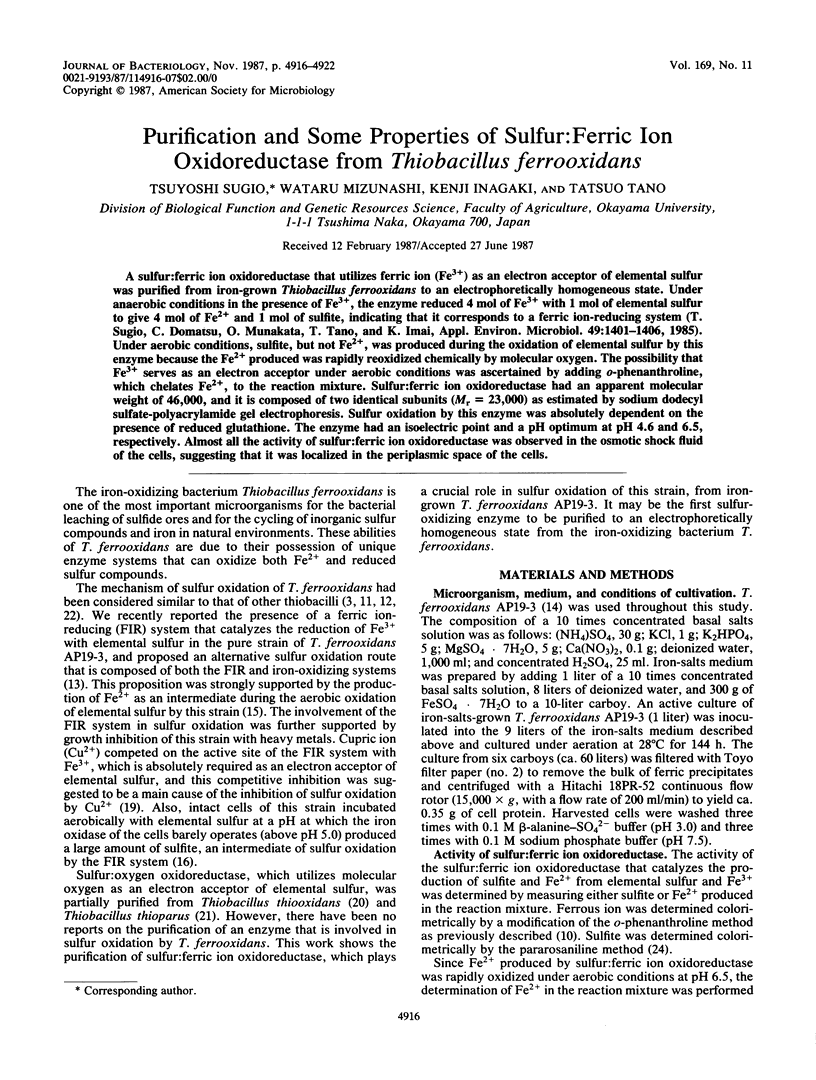Abstract
A sulfur:ferric ion oxidoreductase that utilizes ferric ion (Fe3+) as an electron acceptor of elemental sulfur was purified from iron-grown Thiobacillus ferrooxidans to an electrophoretically homogeneous state. Under anaerobic conditions in the presence of Fe3+, the enzyme reduced 4 mol of Fe3+ with 1 mol of elemental sulfur to give 4 mol of Fe2+ and 1 mol of sulfite, indicating that it corresponds to a ferric ion-reducing system (T. Sugio, C. Domatsu, O. Munakata, T. Tano, and K. Imai, Appl. Environ. Microbiol. 49:1401-1406, 1985). Under aerobic conditions, sulfite, but not Fe2+, was produced during the oxidation of elemental sulfur by this enzyme because the Fe2+ produced was rapidly reoxidized chemically by molecular oxygen. The possibility that Fe3+ serves as an electron acceptor under aerobic conditions was ascertained by adding o-phenanthroline, which chelates Fe2+, to the reaction mixture. Sulfur:ferric ion oxidoreductase had an apparent molecular weight of 46,000, and it is composed of two identical subunits (Mr = 23,000) as estimated by sodium dodecyl sulfate-polyacrylamide gel electrophoresis. Sulfur oxidation by this enzyme was absolutely dependent on the presence of reduced glutathione. The enzyme had an isoelectric point and a pH optimum at pH 4.6 and 6.5, respectively. Almost all the activity of sulfur:ferric ion oxidoreductase was observed in the osmotic shock fluid of the cells, suggesting that it was localized in the periplasmic space of the cells.
Full text
PDF






Images in this article
Selected References
These references are in PubMed. This may not be the complete list of references from this article.
- Andrews P. Estimation of the molecular weights of proteins by Sephadex gel-filtration. Biochem J. 1964 May;91(2):222–233. doi: 10.1042/bj0910222. [DOI] [PMC free article] [PubMed] [Google Scholar]
- Eccleston M., Kelly D. P. Oxidation kinetics and chemostat growth kinetics of Thiobacillus ferrooxidans on tetrathionate and thiosulfate. J Bacteriol. 1978 Jun;134(3):718–727. doi: 10.1128/jb.134.3.718-727.1978. [DOI] [PMC free article] [PubMed] [Google Scholar]
- Hooper A. B., DiSpirito A. A. In bacteria which grow on simple reductants, generation of a proton gradient involves extracytoplasmic oxidation of substrate. Microbiol Rev. 1985 Jun;49(2):140–157. doi: 10.1128/mr.49.2.140-157.1985. [DOI] [PMC free article] [PubMed] [Google Scholar]
- LOWRY O. H., ROSEBROUGH N. J., FARR A. L., RANDALL R. J. Protein measurement with the Folin phenol reagent. J Biol Chem. 1951 Nov;193(1):265–275. [PubMed] [Google Scholar]
- MITCHELL P. Coupling of phosphorylation to electron and hydrogen transfer by a chemi-osmotic type of mechanism. Nature. 1961 Jul 8;191:144–148. doi: 10.1038/191144a0. [DOI] [PubMed] [Google Scholar]
- Mitchell P. Chemiosmotic coupling in oxidative and photosynthetic phosphorylation. Biol Rev Camb Philos Soc. 1966 Aug;41(3):445–502. doi: 10.1111/j.1469-185x.1966.tb01501.x. [DOI] [PubMed] [Google Scholar]
- Mitchell P. Hypothesis: cation-translocating adenosine triphosphatase models: how direct is the participation of adenosine triphosphate and its hydrolysis products in cation translocation? FEBS Lett. 1973 Jul 15;33(3):267–274. doi: 10.1016/0014-5793(73)80209-1. [DOI] [PubMed] [Google Scholar]
- Mitchell P. Keilin's respiratory chain concept and its chemiosmotic consequences. Science. 1979 Dec 7;206(4423):1148–1159. doi: 10.1126/science.388618. [DOI] [PubMed] [Google Scholar]
- Silver M., Lundgren D. G. Sulfur-oxidizing enzyme of Ferrobacillus ferrooxidans (Thiobacillus ferrooxidans). Can J Biochem. 1968 May;46(5):457–461. doi: 10.1139/o68-069. [DOI] [PubMed] [Google Scholar]
- Silver M., Lundgren D. G. The thiosulfate-oxidizing enzyme of Ferrobacillus ferrooxidans (Thiobacillus ferrooxidans). Can J Biochem. 1968 Oct;46(10):1215–1220. doi: 10.1139/o68-181. [DOI] [PubMed] [Google Scholar]
- Sugio T., Domatsu C., Munakata O., Tano T., Imai K. Role of a Ferric Ion-Reducing System in Sulfur Oxidation of Thiobacillus ferrooxidans. Appl Environ Microbiol. 1985 Jun;49(6):1401–1406. doi: 10.1128/aem.49.6.1401-1406.1985. [DOI] [PMC free article] [PubMed] [Google Scholar]
- Sugio T., Domatsu C., Tano T., Imai K. Role of Ferrous Ions in Synthetic Cobaltous Sulfide Leaching of Thiobacillus ferrooxidans. Appl Environ Microbiol. 1984 Sep;48(3):461–467. doi: 10.1128/aem.48.3.461-467.1984. [DOI] [PMC free article] [PubMed] [Google Scholar]
- Suzuki I., Silver M. The initial product and properties of the sulfur-oxidizing enzyme of thiobacilli. Biochim Biophys Acta. 1966 Jul 6;122(1):22–33. doi: 10.1016/0926-6593(66)90088-9. [DOI] [PubMed] [Google Scholar]
- Vestal J. R., Lundgren D. G. The sulfite oxidase of Thiobacillus ferrooxidans (Ferrobacillus ferrooxidans). Can J Biochem. 1971 Oct;49(10):1125–1130. doi: 10.1139/o71-162. [DOI] [PubMed] [Google Scholar]
- Weber K., Osborn M. The reliability of molecular weight determinations by dodecyl sulfate-polyacrylamide gel electrophoresis. J Biol Chem. 1969 Aug 25;244(16):4406–4412. [PubMed] [Google Scholar]




